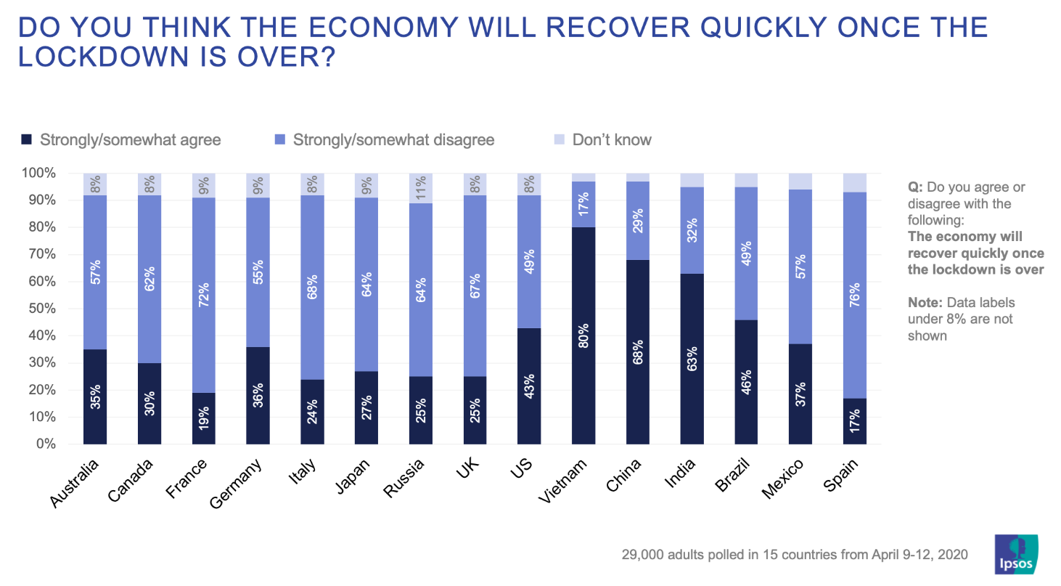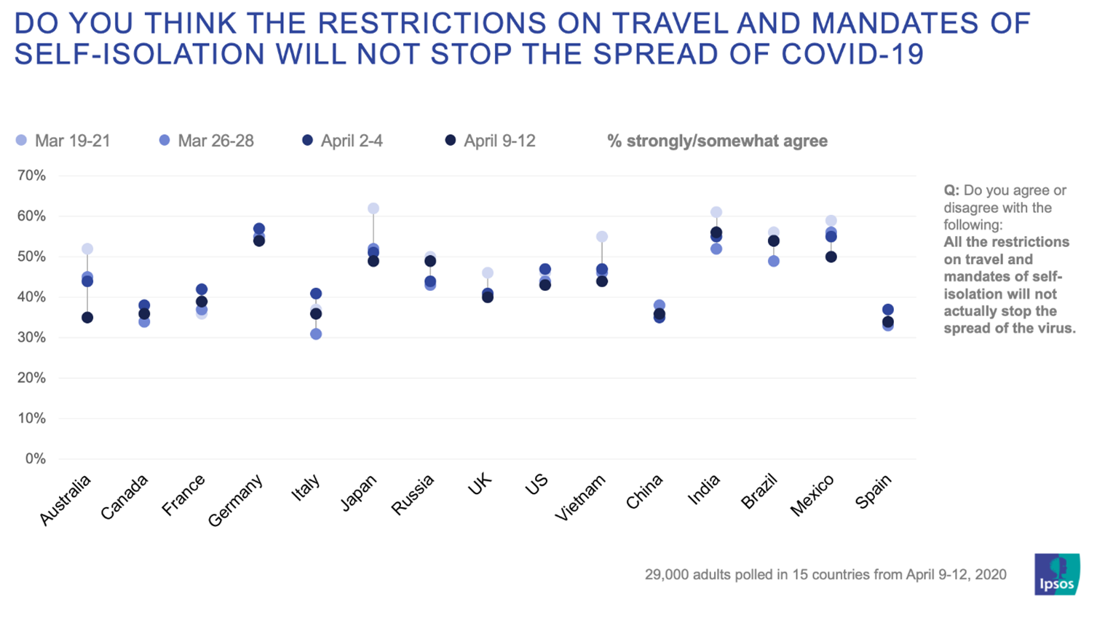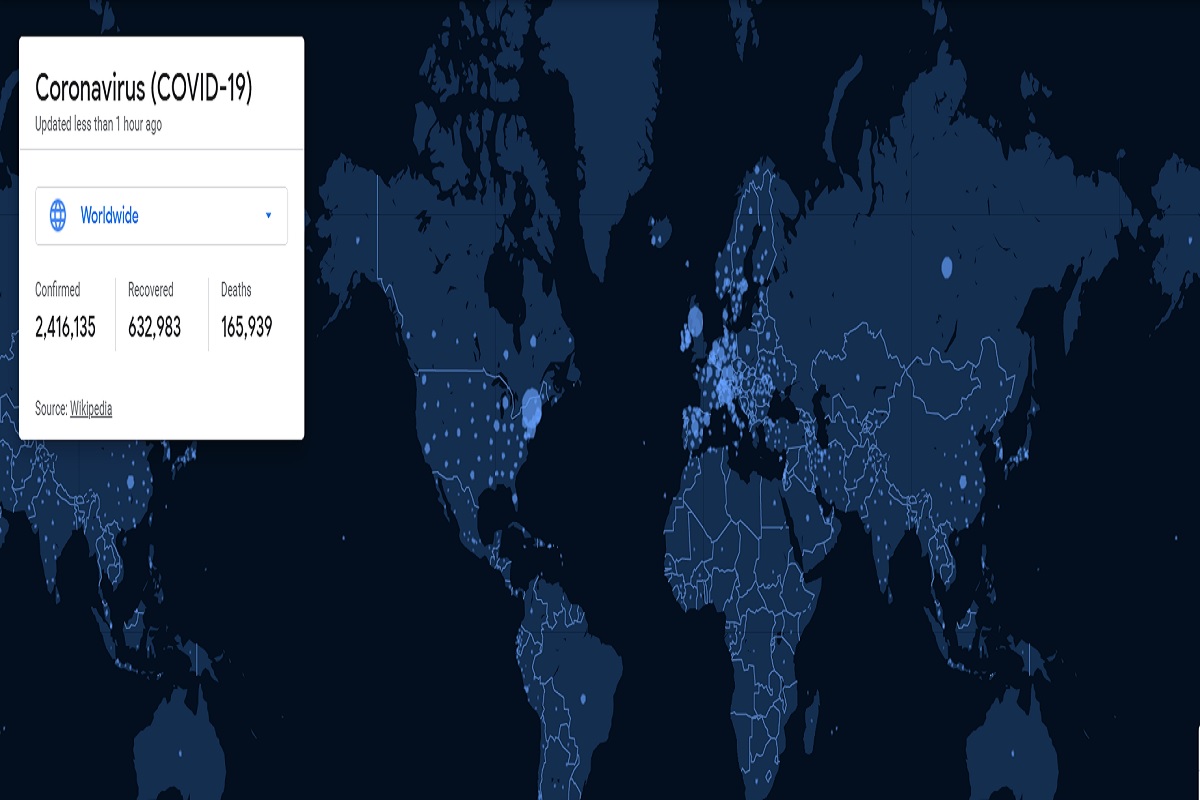Many think it’s unlikely the economy will recover quickly once COVID-19 lockdown is over
Most negative about an economic recovery in hard-hit countries except China
Paris, France April , 2020 — A majority of people in 10 of the 15 countries polled by Ipsos disagree that the economy will recover quickly once the lockdown from the coronavirus pandemic is over – suggesting a lasting impact.
People in Spain (76%), France (72%), Italy (68%), the United Kingdom (67%), Russia and Japan (64%), and Canada (62%) feel most strongly against a quick economic recovery in a survey of nearly 29,000 respondents conducted from April 9 to 12. Those in Vietnam (80%), China (68%) and India (63%) are most likely to say a quick recovery will take place.
At the same time, one of the countries most divided on this question is the world’s largest economy – the United States ̶ with nearly half of those surveyed (49%) disagreeing on a quick recovery, while 43% think it will happen.

In terms of actions taken, majorities in India (56%), Brazil and Germany (54%) say all of the restrictions on travel and mandates for self-isolation will not stop the spread of COVID-19. That compares with majorities in China (63%), Australia (59%), Italy and Canada (58%), Spain (57%), the U.K., and Vietnam (54%) and France (51%) who think the restrictions do work.
Countries that have the seen the most significant change on this measure since mid-March are the ones where optimism has increased. Australia saw a drop of 17 percentage points in the number of those that agree the measures will not stop the spread of the pandemic, while the number of respondents in Japan fell by 13 points.

About the Study
These are the results of an Ipsos survey conducted April 9th to 12th , 2020 on the Global Advisor online platform among 28,000 adults aged 18-74 in Canada and the United States and 16-74 in Australia, Brazil, China, France, Germany, Italy, India, Japan, Mexico, Russia, Vietnam and the United Kingdom. Where available, tracking results from previous studies, conducted through March and selected results from February are referenced by date.
The sample consists of approximately 2,000 individuals in each country with the exception of Vietnam each at 1,000. The samples in Australia, Canada, France, Germany, Italy, Japan, the U.K. and the U.S. can be taken as representative of these countries’ general adult population over age 16 or 18 (as above) and under the age of 75. The sample in Brazil, China, India, Mexico, Russia, and Vietnam is more urban, more educated and/or more affluent than the general population and should be viewed as reflecting the views of the more “connected” segment of the population. The data is weighted so that each market’s sample composition best reflects the demographic profile of the adult population according to the most recent census data. Sample sizes may vary in prior waves.
Where results do not sum to 100 or the ‘difference’ appears to be +/-1 more/less than the actual, this may be due to rounding, multiple responses or the exclusion of don’t knows or not stated responses. The precision of Ipsos online polls are calculated using a credibility interval with a poll of 1,000 accurate to +/- 3.5 percentage points. For more information on the Ipsos use of credibility intervals, please visit the Ipsos website (www.Ipsos.com).

Muddling through the management of a viral pandemic
On December 31, 2019, the World Health Organization (WHO) received report of a
cluster of pneumonia cases in Wuhan, Hubei Province of China. On Jan. 3, and Jan. 8,
2020, Ontario’s Chief Medical Officer of Health emailed this information to all 354
Ontario public health units.
By Jan. 23, 2020, the WHO had identified the outbreak as very high risk in China,
and globally. Canada’s first presumptive case of the Coronavirus was a Toronto male who had just
returned from Wuhan on Jan. 25. By the end of February, COVID-19 had spread to over
50 countries.
As Ontario’s Auditor General Bonnie Lysyk reflects in her Special Report on COVID-19
Preparedness and Management, 2020 will be known as the year of the COVID-19
pandemic. Nobody could have predicted the toll this would take, and continues to
take, on lives and the economy in Canada.
The Auditor General’s report found key lessons of the 2003 SARS outbreak had not
been implemented by the time COVID-19 hit Ontario. In 2015, my legislation on
emerging infectious diseases passed and became law under the previous government.
However, it appears little within my framework legislation saw concrete
implementation.
According to Lysyk, Ontario’s Chief Medical Officer of Health did not fully exercise
his powers under the Health Protection and Promotion Act to respond to COVID-19. He
did not issue directives to local Medical Officers of Health to ensure public health
units responded consistently.
For instance, it was the province and not the Chief Medical Officer of Health that
finally issued an emergency order in early October 2020 to require masking for the
public. Norfolk County had mandated the indoor use of masks on July 24, and
Haldimand did so on July 27.
Variations in management and operations among public health units contributed to
fragmentation and inconsistencies across Ontario. Public health in other
jurisdictions, such as British Columbia, Alberta and Quebec, is more simply
organized. Sadly, public health reforms recommended by the SARS Commission 15 years
ago were not fully implemented. Currently, Ontario’s 34 public health units are
still operating independently, and best practices rarely shared.
My staff dealt with a myriad of inconsistencies between the province and the local
health unit in the pandemic’s first months. This created confusion for constituents
who would listen to Premier Ford’s daily news conferences and believed they
understood the rules only to find the local medical officer of health had issued
tighter restrictions. Local health units cannot loosen restrictions, but can go
above-and-beyond.
While there are many examples, the most controversial surrounded farmers’
bunkhouses. In Haldimand-Norfolk, there is a cap of only three workers per bunkhouse
permitted, no matter the square footage of the living space. Haldimand-Norfolk was
the only jurisdiction in North America to impose such a restriction.
Another example centred around restrictions on cottage owners whose primary
residence was not in Haldimand-Norfolk. While carwashes went dry in towns across the
riding, operators were confused and angry to find these facilities open in towns
like Tillsonburg and Brantford. Similarly, when the Premier encouraged us to get
outside for exercise, residents in our riding were not allowed on local trails.
Despite the on-going scramble, people in Ontario and their institutions are doing an
admirable job navigating these unprecedented times.
Toby Barrett is the MPP for Haldimand-Norfolk
We must all aggressively plan for our recovery
It has been over four months since Ontario’s first case of coronavirus, and our
focus now is getting businesses up and running – and people back to work – in a safe
and responsible manner.
Reopening Ontario is the toughest balancing act we’ve ever had. My staff constantly
hears conflicting opinions; some are adamant we must open immediately, and there are
those fearful of opening too quickly.
Across Ontario, 402,800 jobs were lost in March and 689,200 in April.
Those numbers underscore the significant impact of COVID-19, and serve as a stark
reminder of the personal impact of this crisis, in addition to those whose health
this virus has impacted.
The people behind those numbers are on our minds as we focus on creating jobs and
fostering growth.
The timing of our recovery continues to be informed by the advice of medical
experts, and the best practices of places previously hit by COVID.
We are also looking to economists, businesses and labour leaders, workers, families
and entrepreneurs for advice.
We want every Ontarian to get back to work as soon as it is safe, with a clear path
to economic recovery that keeps people protected and healthy.
But people want us to be cautious – a message that I hear through my office and
delivering masks door-to-door in towns like Hagersville and Jarvis. We don’t want
the hard work and sacrifice of people in Haldimand-Norfolk, and 14.5 million
Ontarians, to be for nothing. That’s why we are taking a gradual, staged approach to
opening things up.
Thanks to the perseverance of people and businesses, we can start to carefully ease
restrictions, get businesses open and people back to work.
On May 19, we entered the first stage of our reopening process. Seasonal businesses
like marinas, trailer parks, nurseries and golf courses are open – as are certain
retail stores, with a street entrance as opposed to an entrance from a mall. Health
and medical services have been allowed to resume. Constructions sites are getting
back up and running.
We have also provided public health guidance to keep families, employees and
customers safe and healthy – with more than 90 workplace safety guidelines.
It remains critical that we continue to maintain physical distancing or wear a mask,
wash our hands frequently, use hand sanitizers, and keep commonly used surfaces
clean. We should also get tested if we think we have come in contact with the
virus, even if we have no symptoms.
People are compassionate, patient and careful – I see it at the door and hear it on
the telephone – which is why we have steadily been making progress.
COVID-19 is an extraordinary threat to the health and economy of Ontario – the
greatest we’ve seen in our lifetimes. It requires extraordinary measures from all of
us because we’re all in this together regardless of where we live on the planet.
The irony is we’re often in this together while working remotely. Between our
responsibilities in Haldimand-Norfolk and our work as Parliamentary Assistant to the
Minister of Agriculture, Food & Rural Affairs, our office has often been around the
clock interacting with farmers, business people, public servants, and citizens. Our
days go from teleconferences, to iPhones, to webinars, to Zooms. The work is
satisfying and necessary as we work to protect people while planning Ontario’s
recovery.
Toby Barrett MPP for Haldimand-Norfolk
Future uncertainty: Why people don’t see a quick economic recovery from coronavirus
Consumer confidence and poll on economic outlook show doubts about recovery ahead.
News that quarterly growth contracted significantly in the world’s second biggest economy – China – for the first time in 28 years, skyrocketing jobless numbers in the U.S., and warnings from oil cartel OPEC that demand will fall to a 30-year low, have many wondering if it really will be business as usual once the coronavirus pandemic is over.
Our latest global poll results show people have some serious doubts despite reassurances from many governments that we will see a quick recovery in the economy once the outbreak is under control.
The majority of people in 10 out of the 15 countries surveyed say a quick economic recovery is unlikely once the lockdown from the pandemic is lifted, with this sentiment highest in hard-hit European countries.
Nearly three in four people in Spain (76%), and France (72%) are most negative about a quick recovery, followed by those in Italy (68%), the United Kingdom (67%), Russia and Japan (64%).
Experts say a combination of uncertainty over when the shutdowns will end, a resulting loss of wealth, the speed and depth of the downturn, and the risk of a new outbreak without a vaccine are all factors weighing on people’s confidence about the economy bouncing back.
Doug Porter, Chief Economist at BMO Financial Group, said the reality is that the virus is in charge and until we have better clarity on the path infections take, people can’t be fully confident on where the economy is headed.
“The fact that people have been directly affected ̶ whether through their jobs or their investments ̶ likely makes them wary about a broader economic recovery,” said Porter. “The fact that job losses have been so widespread and affected so many people directly accentuate the impact.”
The loss of confidence
The Ipsos’ Global Consumer Confidence Index released last week for April fell to its lowest level in more than seven years – since December 2012. The expectations index, which reflects consumers’ outlook on their job, financial situation, and local economy showed an even bleaker picture – declining four points lower than at any time in its decade-long history.
Royce Mendes, Senior Economist at CIBC Capital Markets, said it won’t be business as usual until consumers feel comfortable eating at crowded restaurants or taking a leisurely stroll through a mall.
“Whether or not governments lift restrictions on activity, that won’t happen until there is a vaccine,” said Mendes. “Many companies will be able to bounce back nicely. But, unfortunately, there will be some businesses that don’t survive the period of shutdowns.”
Other businesses might be operating at severely reduced capacity or will have taken on additional debt burdens and, therefore, won’t be able bring back all of their prior workforce, according to Mendes.
“Uncertainty about employment prospects when this is all over will have more households cautious about a recovery,” he added.
The latest government figures show that 22 million people in the U.S. have applied for unemployment insurance in four weeks, while job losses are in the millions in other major economies around the world.
The dangers of reopening the economy
In light of this, there have been announcements last week from governments globally on plans to reopen the economy. Germany will gradually reopen some small businesses starting on Monday, while schools are set to open in May. Switzerland announced similar moves for the end of the month and early May.
China, meanwhile, has been criticized for opening up parts of its economy even as it revised the death toll in the city of Wuhan ̶ where the virus originated ̶ higher by 50% on Friday. U.S. President Donald Trump has also unveiled plans for states to ease lockdowns gradually.
But Krishen Rangasamy, Senior Economist at National Bank of Canada, said this pandemic, if anything, has shown that governments and authorities can lose control of the situation either through lack of preparation or bad luck, or a combination of both.
“Once people lose confidence, it can take some time before they start trusting authorities again,” said Rangasamy. “Governments will do well to not over-promise considering there are so many unknowns at this point. Reopening the economy too soon could back-fire with unnecessary loss of lives, and an economic relapse.”
Brad Setser, Senior Fellow at the Council on Foreign Relations in Washington D.C., added that government forecasts indicating a return to business as usual are likely too optimistic.
“Obviously this shock is unique, but it is worth recalling that the recovery from the global financial crisis was also slow,” Setser said. “It would be helpful if governments recognized that it will likely take time to get COVID-19 fully under control, and thus, a full recovery is still some time away.”
Experts agree the pace of a recovery, likely in the second half of the year, is uncertain, because it depends on the extent of the damage in the first half such as the permanent loss of industrial capacity. They say current economic indicators point to an ongoing downturn.
“A full recovery will likely hinge on developing effective therapeutic treatments for COVID-19, if not an effective vaccine,” said Setser. “Government support for the economy is also likely to be necessary for an extended period of time.”
“It is better to plan for the worst and be pleasantly surprised than to be caught unprepared.”
https://www.ipsos.com/en/why-people-dont-see-quick-economic-recovery-coronavirus